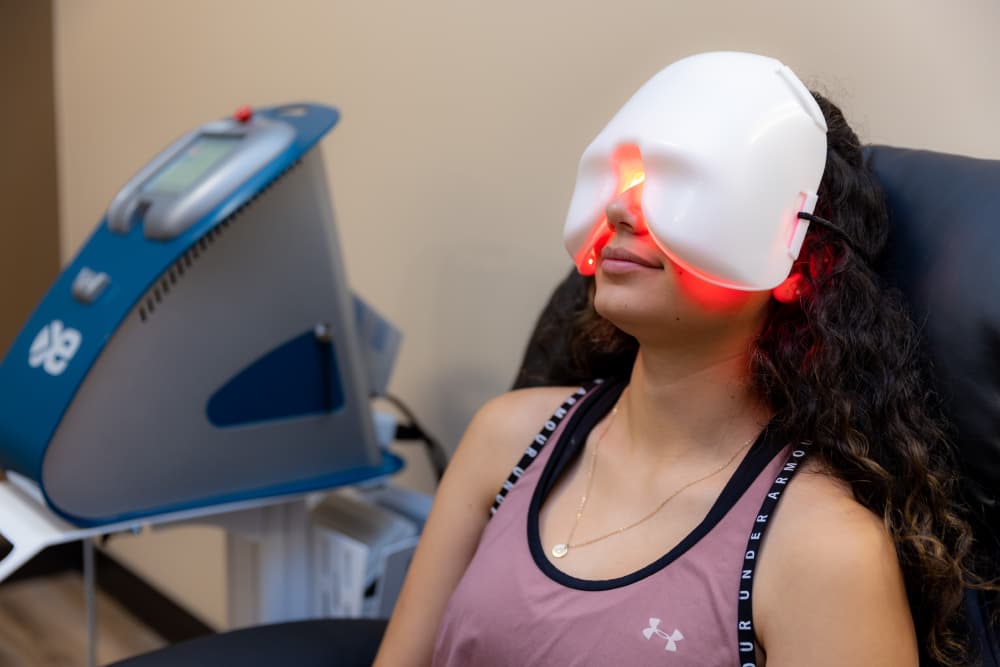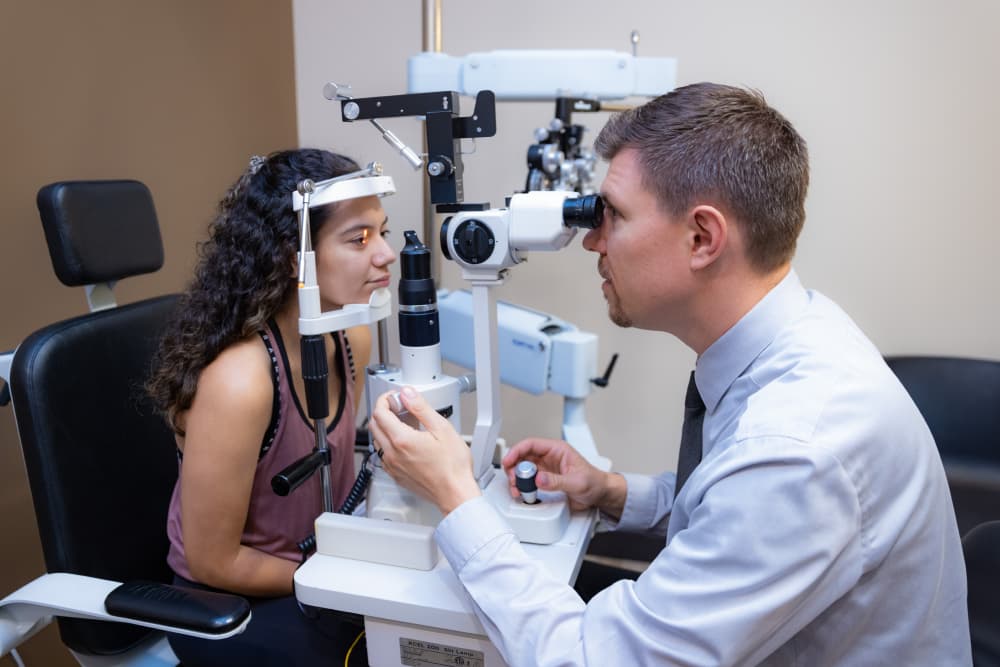What is dry eye syndrome?
Dry eye syndrome is a common condition characterized by insufficient tear production or poor tear quality, leading to discomfort and potential vision problems. Tears are essential for maintaining the health and lubrication of the eyes. When the quantity or quality of tears is inadequate, the eyes may become dry, irritated, and inflamed.
Common symptoms of dry eye
Dry eye can manifest through various symptoms, including:
- Persistent dryness or grittiness in the eyes
- Burning or stinging sensation
- Redness and irritation
- Excessive tearing (paradoxically, as the eyes try to compensate for dryness)
- Blurred vision, especially during prolonged periods of reading or computer use
- Sensitivity to light (photophobia) If you experience any of these symptoms, it’s essential to seek professional evaluation and treatment to prevent potential complications.
Causes of dry eye syndrome
Dry eye can be caused by a variety of factors, including:
- Aging: Tear production tends to decrease with age, making older adults more susceptible to dry eye.
- Environmental factors: Dry climates, windy conditions, smoke, and air conditioning can all contribute to dry eye symptoms.
- Hormonal changes: Fluctuations in hormone levels, such as those experienced during menopause, can affect tear production.
- Medications: Certain medications, including antihistamines, decongestants, antidepressants, and hormone replacement therapy, can reduce tear production.
- Medical conditions: Autoimmune diseases such as Sjögren’s syndrome, rheumatoid arthritis, and lupus can cause dry eye by affecting the body’s ability to produce tears.
- Prolonged screen time: Extended use of computers, smartphones, and other digital devices can reduce blink frequency and lead to evaporative dry eye. Identifying and addressing the underlying cause of dry eye is crucial for effective management and relief of symptoms.
Diagnosis of dry eye syndrome
Diagnosing dry eye involves a comprehensive evaluation of your symptoms, medical history, and specialized tests. These may include:
- Assessment of symptoms: Your optometrist will inquire about your symptoms, lifestyle factors, and any medications you’re taking.
- Tear film evaluation: Specialized tests may be performed to analyze the quantity and quality of your tears, including tear breakup time (TBUT) and Schirmer’s test.
- Meibomian gland assessment: Evaluation of the meibomian glands, which produce the oily layer of tears, may be conducted using imaging techniques such as infrared meibography.
- Ocular surface examination: A thorough examination of the cornea, conjunctiva, and eyelids may be performed using a slit lamp biomicroscope.
- Additional tests: In some cases, additional tests such as tear osmolarity testing or corneal topography may be recommended to further assess the severity and underlying causes of dry eye. Based on the results of these evaluations, your optometrist can develop a personalized treatment plan to alleviate your dry eye symptoms and improve your ocular comfort and health.
Treatment options for dry eye
Treatment for dry eye syndrome aims to alleviate symptoms, improve tear production and quality, and address any underlying causes. Depending on the severity and underlying factors contributing to your dry eye, treatment options may include:
- Artificial tears: Lubricating eye drops can help relieve dryness and provide temporary relief from symptoms.
- Prescription medications: Anti-inflammatory eye drops, immunosuppressants, or medications that stimulate tear production may be prescribed in cases of moderate to severe dry eye.
- Punctal plugs: These tiny plugs can be inserted into the tear ducts to block drainage and help retain tears on the ocular surface.
- Lifestyle modifications: Simple changes such as taking regular breaks during screen time, using a humidifier to add moisture to the air, and staying hydrated can help alleviate dry eye symptoms.
- Nutritional supplements: Specific Omega formulas and other dietary supplements may help improve tear production and reduce inflammation in some individuals.
- In-office procedures: Advanced treatments such as intense pulsed light therapy (IPL):
 Low Light Level Therapy (LLLT), meibomian gland expression, or scleral contact lenses may be recommended for severe or refractory cases of dry eye. IPL uses a specific wavelength of light placed around the eyes to treat inflammation and reduce unhealthy bacteria around the eyes. LLLT is a relaxing light treatment using medical grade LEDs concentrated on and around the eyes to reactivate the moisture system of your eyes and unclog your meibomian glands to increase the production of your tears.
Low Light Level Therapy (LLLT), meibomian gland expression, or scleral contact lenses may be recommended for severe or refractory cases of dry eye. IPL uses a specific wavelength of light placed around the eyes to treat inflammation and reduce unhealthy bacteria around the eyes. LLLT is a relaxing light treatment using medical grade LEDs concentrated on and around the eyes to reactivate the moisture system of your eyes and unclog your meibomian glands to increase the production of your tears.
Detailed Description of Diagnostic Tools
Tear Film Analysis
Tears play a vital role in maintaining the health and comfort of your eyes. Tear film analysis is a comprehensive assessment of the quantity and quality of your tears, providing valuable insights into your ocular health and the presence of dry eye syndrome. During tear film analysis, your optometrist may use specialized techniques and equipment to evaluate various aspects of your tears, including tear breakup time (TBUT), tear osmolarity, and tear meniscus height.
Tear Osmolarity Testing
Tear osmolarity testing measures the concentration of salt in your tears, which can provide valuable information about the stability and health of the tear film. Elevated tear osmolarity is associated with inflammation and ocular surface damage, commonly seen in dry eye syndrome. By accurately assessing tear osmolarity, your optometrist can diagnose dry eye early and monitor the effectiveness of treatment interventions over time.
Infrared Meibography
The meibomian glands, located along the eyelid margins, play a crucial role in producing the oily layer of tears that prevents evaporation and maintains tear film stability. Infrared meibography is a non-invasive imaging technique that allows your optometrist to visualize the structure and function of the meibomian glands. By assessing the health and integrity of these glands, your optometrist can identify any abnormalities or blockages contributing to evaporative dry eye and develop targeted treatment strategies to improve gland function.
Corneal Topography
Corneal topography is a diagnostic imaging technique used to map the curvature and shape of the cornea, the transparent front surface of the eye. By analyzing corneal topography, your optometrist can detect irregularities, such as corneal astigmatism or irregular astigmatism, which may contribute to dry eye symptoms or affect the quality of your vision. Corneal topography is particularly useful in assessing the impact of contact lens wear on the ocular surface and guiding the selection of appropriate contact lens designs for optimal comfort and visual outcomes.
Biomicroscopy (Slit-Lamp Examination)
Biomicroscopy, also known as a slit-lamp examination, is a powerful tool used to examine the anterior segment of the eye in detail, including the tear film, cornea, conjunctiva, and anterior chamber. During biomicroscopy, your optometrist will use a specialized microscope equipped with a slit lamp to illuminate and magnify various structures of the eye. This allows for a comprehensive assessment of ocular health and the detection of any abnormalities or signs of dry eye, such as corneal staining, conjunctival inflammation, or meibomian gland dysfunction.
By utilizing advanced diagnostic tools such as tear film analysis, tear osmolarity testing, infrared meibography, corneal topography, and biomicroscopy, your optometrist can accurately diagnose dry eye syndrome and develop personalized treatment plans tailored to your individual needs. Early detection and intervention are key to preserving ocular comfort and maintaining optimal eye health.







